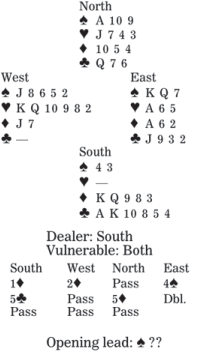Try to help partner if he is watching
By Phillip Alder ( China Daily ) Updated: 2015-08-08 08:09:35
 |
|
Bridge card. [Photo/China Daily] |
Mikhail Baryshnikov modestly said, "No dancer can watch Fred Astaire and not know that we all should have been in another business."
A bridge player who watches all of the cards will be in demand. If he also interprets them correctly, he will receive top billing.
In today's deal, how should East-West defend against five diamonds after West leads a spade? Which spade should West select?
West used a Michaels Cue-Bid to show at least 5-5 in the majors. It was aggressive, especially vulnerable, with only seven high-card points. Then, East ought to have responded four diamonds to ask his partner to choose the trump suit. (Here, neither four spades nor five hearts can be defeated.) South, who opened one diamond, not one club, because of his limited high-card content, bravely battled on with five clubs. (Note that this guaranteed at least five clubs. With only four, he would have bid four no-trump.) North, thinking that his partner might be 6-5, corrected to five diamonds, and East happily doubled.
West wanted to gain a club ruff. So, when he decided not to lead the heart king, he chose the spade two - his lowest card being a suit-preference signal for the lower-ranking of the other two side suits.
South won with dummy's ace and led a trump. East jumped in with his ace and could have either immediately shifted to a club, or first cashed the spade king (West would have played the five, again his lowest) before giving his partner the lethal club ruff.
|
|
|
|
|
|
|
|

























 Raymond Zhou:
Raymond Zhou: Pauline D Loh:
Pauline D Loh: Hot Pot
Hot Pot Eco China
Eco China China Dream
China Dream China Face
China Face






